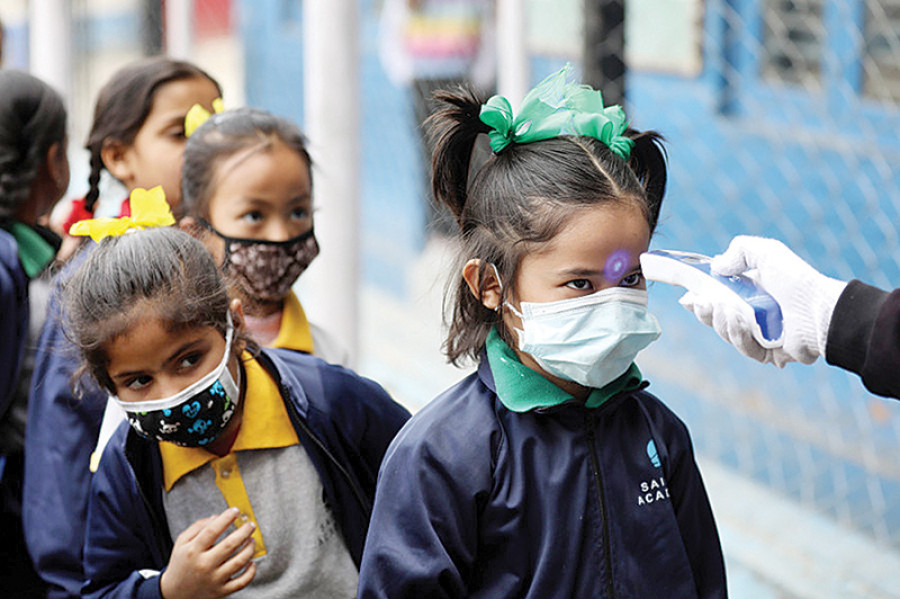National
Pandemic could widen the learning achievement gap between students from private and public schools, educationists warn
Government officials say they are more focused on connecting all school children to teaching-learning activities and it is too early to think about the quality of education in public and private schools.
Binod Ghimire
Second grader Aagya Ghimire is busy taking her first terminal exams online.
She attends Laliguras School, a private institute, at Narephant, Kathmandu. Because of the Covid-19 pandemic, the school conducted virtual classes for some months and now it is conducting online exams.
Aagya’s results should be out by the time Dashain vacation starts in two weeks.
“I am happy with this teaching style and the way the examinations are being conducted,” said her father TN Ghimire. “She has learnt what a grade two student should be knowing.”
Aagya represents children who go to private schools. After two or three months of online classes, students at most private schools are either taking the terminal exams or preparing for them.
But things are entirely different for those children who are enrolled in government-run schools.
Anjana Wayiwa is also a second grader like Aagya. But she goes to a public school where there is no facility for online classes.
Her school, Rastriya Secondary School at Gaighat, Udayapur, only started classes last week. Since the school did not have resources to conduct virtual classes, it decided to wait until the situation is safe to open its classrooms for regular teaching-learning activities.
“We were told by the school the classes will run only for the next 10 days before Dashain. So we have decided to send our daughter to school after the festival holidays,” said Anjana’s mother, Sunita.
There are some seven million school-level students in the country and around 80 percent of them attend public schools. The majority of these students do not have the privilege of taking their lessons virtually from their homes unlike their private school-going counterparts.
Parents and educationists worry the Covid-19 pandemic could further widen the gap in learning achievement between the children from private and public schools.
There is already a huge divide between private and public schools in the country.
The Secondary Education Examinations results, which is taken as a cumulative test of students’ learnings in their entire school years, show just how far behind the students going to public schools are compared to those who attend private schools.
Last year for instance, out of 325,330 students who took the SEE exams from public schools, only 2,792 (0.8 percent) scored above 3.60 GPA. Meanwhile, out of 133,945 SEE examinees from private schools, 14,788 (11 percent) secured above 3.60 GPA.
Similarly,11,233 public school students (3.45 percent) got GPAs that ranged from 3.20 to 3.60 while 39,914 private school students (29.7 percent) secured the same grades.
The gap in the levels of learning achievement among public and private school students will ultimately lead to a class division, says Kedar Bhakta Mathema, former vice-chancellor at Tribhuvan University.
“Education can be a great equaliser only when every child gets the same level of learning opportunity,” said Mathema, who has led different commissions suggesting reforms in the country’s education sector in the past.
“Poor learning achievement among public school students means fewer number of these students will go on to have a better higher education and ultimately a better career.”
Suprabhat Bhandari, chairperson of the Guardian’s Federation Nepal, agrees that schools in Nepal have become a class marker and the Covid-19 pandemic has made the class distinction even more pronounced.
“Parents who are not doing well economically enrol their children in public schools because they cannot afford private school tuition. They also cannot afford the technology required for online classes. So no wonder public school students are lagging behind in their studies during the pandemic,” said Bhandari.
Susan Acharya, a professor at the Tribhuvan University, says the disparity in the quality of education is not just limited between public and private schools.
“There is a marked difference in the quality of education among private schools as well. Students from well-to-do private schools are doing rather well but smaller private schools have been struggling because of the pandemic,” she said.
“The learning achievement of the economically weaker section in the society is dwindling due to the pandemic.”
Education experts say reforming the public school system is the only way to ensure the same level of education to all children, regardless of their economic backgrounds.
They say the pandemic should serve as an impetus for the government to redevelop and reimagine the country’s school system.
Meanwhile, government officials say they haven’t given any thoughts about the learning achievement at this point, because their focus has been on connecting more and more students in the teaching-learning activities.
“We can only evaluate the learning achievement of students once they all have had the learning opportunity,” said Baikuntha Aryal, director general at the Centre for Education and Human Resource Development.
“I also don’t think every child from private schools has been connected to the teaching-learning activities. So it is too early to talk about the gap between the private and public schools.”




 20.78°C Kathmandu
20.78°C Kathmandu














